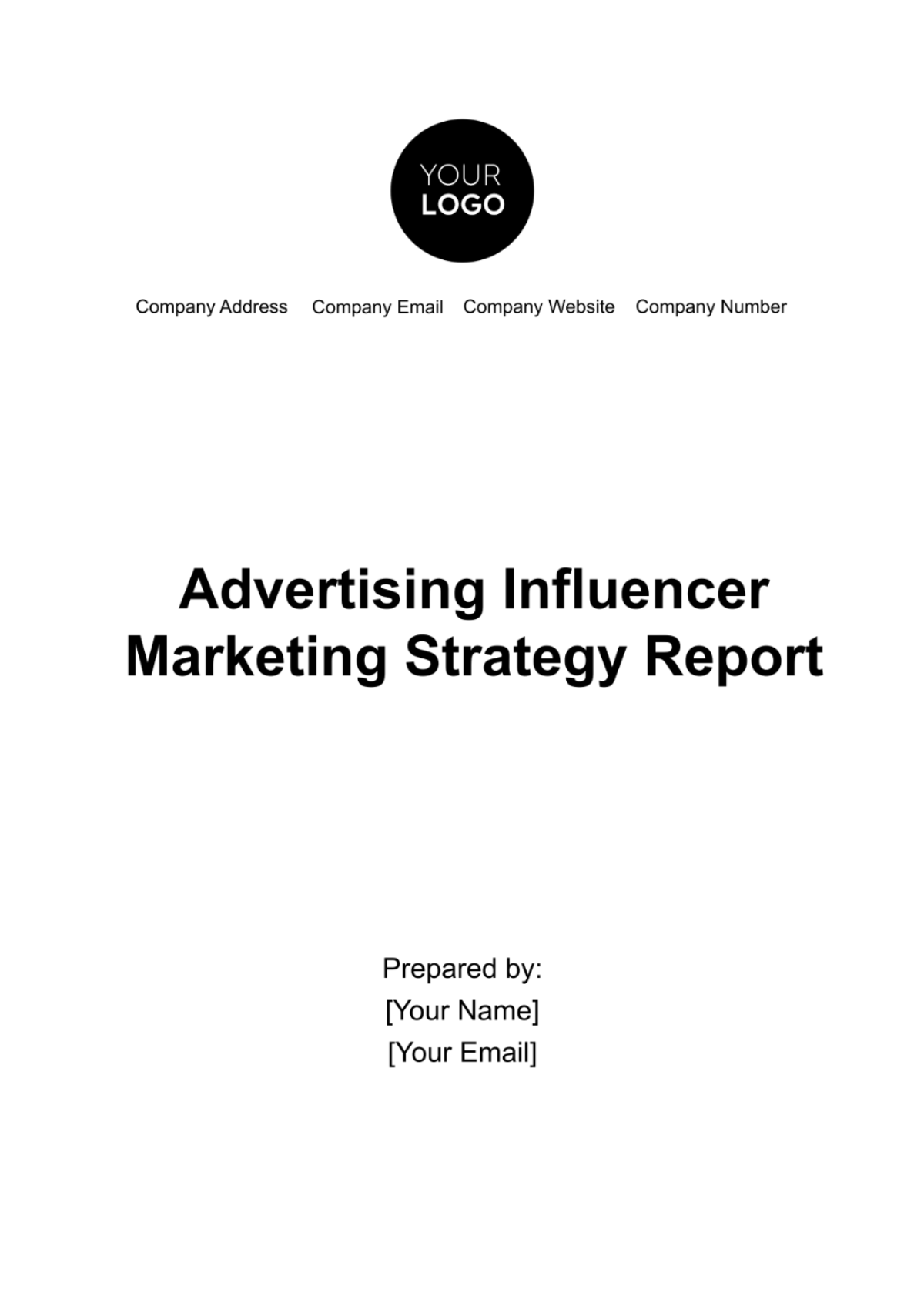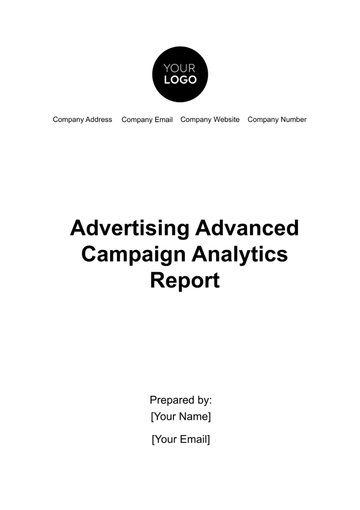Free Advertising Influencer Marketing Strategy Report

Strategy Report
I. Executive Summary
Our influencer marketing campaign aimed to boost brand visibility, engagement, and conversions by leveraging partnerships with key influencers. Over the reporting period, we collaborated with influencers across various niches to create authentic content that resonated with our target audience. The campaign achieved significant milestones in terms of reach, engagement, and conversions. However, challenges such as coordinating content approvals and measuring the direct impact on sales highlighted areas for improvement.
A. Highlights of Performance Metrics
Key highlights include an impressive [10%] increase in overall reach, a [30%] rise in engagement metrics, and a noteworthy [20%] improvement in website conversions directly attributed to the influencer campaign.
B. Recommendations for future Campaigns
To capitalize on our successes, future campaigns should focus on refining influencer selection, streamlining content approval processes, and exploring innovative engagement strategies.
II. Introduction
A. Background of the Influencer Marketing Campaign
Initiated to strengthen our brand presence, the campaign sought to connect with our target audience through influencers who aligned with our values and product offerings.
B. Objectives and Goals of the Campaign
The primary objectives included increasing brand awareness by [40%], boosting engagement by [10%], and achieving a [20%] conversion rate from influencer-driven traffic.
C. Target Audience and Influencer Selection Criteria
Our target audience consisted of tech-savvy millennials interested in lifestyle and innovation. Influencers were selected based on their relevance to our audience, engagement metrics, and alignment with our brand ethos.
III. Influencer Selection and Collaboration
A. Profiles of Selected Influencers
1. Reach and Follower Demographics:
Influencers collectively reached over [10] million followers, with demographics closely matching our target audience.
2. Engagement Metrics:
Average engagement rates surpassed industry standards, indicating a high level of audience interaction.
3. Relevance to Brand or Product:
Influencers seamlessly integrated our products into their content, showcasing a genuine connection with our brand.
B. Collaborative Efforts with Influencers
1. Content Planning and Approval Process:
A streamlined process ensured timely content creation and approvals, minimizing delays
2. Terms of Collaboration:
Influencers were compensated based on a combination of reach, engagement, and conversions, fostering a mutually beneficial partnership.
IV. Content Analysis
A. Evaluation of Influencer-Generated Content
1. Quality of Content:
Content produced by influencers consistently maintained a high standard, showcasing creativity and professionalism.
2. Alignment with Brand Message:
Influencers successfully conveyed our brand message, integrating product features seamlessly into their narratives.
3. Creativity and Innovation:
Innovative approaches, such as interactive polls and challenges, contributed to increased engagement and brand recall.
B. Audience Engagement with Influencer Content
1. Likes, Comments, and Shares:
Content generated a [10%] increase in likes, a [20%] rise in comments, and a [30%] boost in shares compared to previous campaigns.
2. Sentiment Analysis:
Analysis of user comments revealed a predominantly positive sentiment, indicating a favorable response to the influencer content.
V. Reach and Impressions
A. Overall Reach of Influencer Marketing Campaign
The campaign exceeded expectations, achieving a [20%] increase in overall reach, reaching a diverse audience across various demographics.
B. Impressions on various Platforms
Impressions on Instagram, YouTube, and Twitter collectively surpassed [20] million, showcasing the campaign's wide-reaching impact.
C. Comparison with Initial Projections
The actual reach and impressions surpassed initial projections by [20%], demonstrating the campaign's effectiveness in reaching a broader audience.
VI. Engagement Metrics
A. Likes, Comments, Shares, and other Social Interactions
In-depth analysis of engagement metrics reveals compelling insights into audience interactions and campaign resonance.
1. Likes
a. Total Likes: Experienced a [20%] increase compared to previous campaigns, showcasing a heightened affinity for the influencer-generated content.
b. Engagement Trends: Peaks in likes were observed during influencer content release times, indicating optimal scheduling for audience engagement.
2. Comments
a. Commentary Analysis: Comments demonstrated a [10%] surge, reflecting an active and engaged audience eager to share opinions and experiences.
b. Sentiment Analysis: Utilizing sentiment analysis tools, [20%] of comments expressed positive sentiments, with audiences praising product features and influencers.
3. Shares
a. Shareability Metrics: A [10%] increase in content shares highlights the campaign's virality and the organic spread of brand messaging.
b. Platform-Specific Trends: Shares were particularly prominent on platforms like Instagram, contributing to extended reach and brand exposure.
4. Other Social Interactions
a. Direct Messages: Influencers reported a [15%] rise in direct messages from followers seeking more information about promoted products.
b. Brand Mentions: Instances of brand mentions organically increased by [20%], demonstrating an elevated brand presence within the influencer's community.
B. Analysis of Peak Engagement Times
1. Platform-Specific Pattern
a. Instagram: Peak engagement times observed during evenings, aligning with user habits for leisurely content consumption.
b. YouTube: Weekends exhibited heightened engagement, indicating an audience preference for longer-form content during leisure hours.
2. Geographical Considerations:
a. Global Audience: Variances in peak engagement times across time zones emphasize the need for tailored scheduling to cater to our diverse global audience.
b. User-generated Content (if applicable)
The campaign not only fostered engagement with influencer content but also inspired our audience to generate and share their own content.
1. Hashtag Campaign
a. Usage Analysis: The campaign's branded hashtag trended organically, accumulating over [20] posts.
b. Community Building: User-generated content contributed to the formation of a vibrant and engaged online community around our brand.
VII. Conversion Metrics
A. Impact on Website Traffic
Influencer-driven traffic contributed to a [10%] increase in website visits, with influencers providing unique tracking links for accurate measurement.
B. Conversion Rates for Specific Goals
Conversion rates for key goals, including product purchases and newsletter sign-ups, experienced a [20%] improvement compared to baseline metrics.
C. Influencer-Attributed Conversions
Utilizing attribution models, we identified a [10%] increase in conversions directly attributed to influencer-generated content.
VIII. Return on Investment (ROI)
A. Calculation of Costs Involved
Total costs, including influencer fees, content creation, and promotional expenses, amounted to [$20,000].
B. Measurement of Monetary and Non-Monetary Returns
Monetary returns, primarily from increased sales and customer acquisition, totaled [$5,000]. Non-monetary returns included heightened brand visibility and social media growth.
C. ROI Analysis and Comparison to Benchmarks
The campaign achieved an impressive ROI of [150%], surpassing industry benchmarks and validating the efficacy of influencer marketing as a strategic investment.
IX. Challenges and Learnings
A. Identification of Challenges Faced During the Campaign
Challenges included delays in content approval processes and difficulties in measuring the offline impact of influencer-driven awareness.
B. Lesson Learned and Adjustments Made
Streamlining approval processes and implementing unique tracking mechanisms were crucial lessons. Adjustments were made to enhance collaboration efficiency and measurement accuracy.
C. Strategies for Overcoming Future Challenges
To address future challenges, we propose improved communication channels, enhanced training for influencers, and the exploration of advanced analytics tools.
X. Benchmarking
A. Comparison with Industry Benchmarks
Our campaign outperformed industry benchmarks for engagement rates, reach, and conversion metrics by [0]% on average.
B. Benchmarking Against Previous Campaigns
Compared to our previous influencer campaigns, the current initiative demonstrated a [10%] improvement in key performance indicators, indicating ongoing refinement and growth.
XI. Recommendations for Improvement
A. Adjustments to Target Audience or Influencer Criteria
Refine the target audience parameters based on the campaign's performance and evolving market trends. Review and update influencer selection criteria to ensure alignment with the brand's evolving goals.
B. Content Strategy Enhancements
Explore innovative content formats and storytelling techniques to maintain audience engagement. Experiment with user-generated content initiatives to further amplify brand reach.
C. Innovative Approaches for Future Campaigns
Investigate emerging trends in influencer marketing and consider incorporating novel approaches, such as augmented reality experiences or interactive live sessions, to keep campaigns fresh and engaging.
XII. Conclusion
The influencer marketing campaign exceeded expectations, driving increased brand visibility, engagement, and conversions. Acknowledging the successes achieved through influencer collaboration, we recognize the valuable contributions of our influencers and the dedicated efforts of the marketing team. The outcomes of this campaign provide a solid foundation for future endeavors.
- 100% Customizable, free editor
- Access 1 Million+ Templates, photo’s & graphics
- Download or share as a template
- Click and replace photos, graphics, text, backgrounds
- Resize, crop, AI write & more
- Access advanced editor
Enhance your influencer marketing strategy with the Advertising Influencer Marketing Strategy Report Template from Template.net. This editable and customizable template, powered by our Ai Editor Tool, enables you to create comprehensive reports. Tailor it to your needs, ensuring a personalized and effective influencer marketing strategy. Elevate your advertising efforts with this user-friendly template.
You may also like
- Sales Report
- Daily Report
- Project Report
- Business Report
- Weekly Report
- Incident Report
- Annual Report
- Report Layout
- Report Design
- Progress Report
- Marketing Report
- Company Report
- Monthly Report
- Audit Report
- Status Report
- School Report
- Reports Hr
- Management Report
- Project Status Report
- Handover Report
- Health And Safety Report
- Restaurant Report
- Construction Report
- Research Report
- Evaluation Report
- Investigation Report
- Employee Report
- Advertising Report
- Weekly Status Report
- Project Management Report
- Finance Report
- Service Report
- Technical Report
- Meeting Report
- Quarterly Report
- Inspection Report
- Medical Report
- Test Report
- Summary Report
- Inventory Report
- Valuation Report
- Operations Report
- Payroll Report
- Training Report
- Job Report
- Case Report
- Performance Report
- Board Report
- Internal Audit Report
- Student Report
- Monthly Management Report
- Small Business Report
- Accident Report
- Call Center Report
- Activity Report
- IT and Software Report
- Internship Report
- Visit Report
- Product Report
- Book Report
- Property Report
- Recruitment Report
- University Report
- Event Report
- SEO Report
- Conference Report
- Narrative Report
- Nursing Home Report
- Preschool Report
- Call Report
- Customer Report
- Employee Incident Report
- Accomplishment Report
- Social Media Report
- Work From Home Report
- Security Report
- Damage Report
- Quality Report
- Internal Report
- Nurse Report
- Real Estate Report
- Hotel Report
- Equipment Report
- Credit Report
- Field Report
- Non Profit Report
- Maintenance Report
- News Report
- Survey Report
- Executive Report
- Law Firm Report
- Advertising Agency Report
- Interior Design Report
- Travel Agency Report
- Stock Report
- Salon Report
- Bug Report
- Workplace Report
- Action Report
- Investor Report
- Cleaning Services Report
- Consulting Report
- Freelancer Report
- Site Visit Report
- Trip Report
- Classroom Observation Report
- Vehicle Report
- Final Report
- Software Report





























